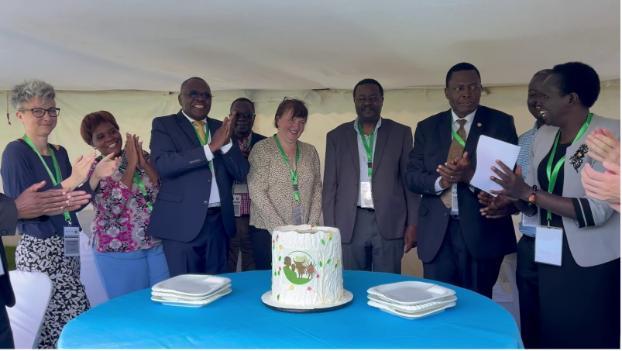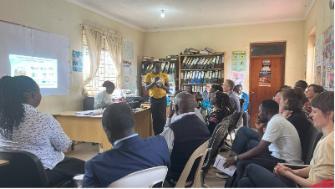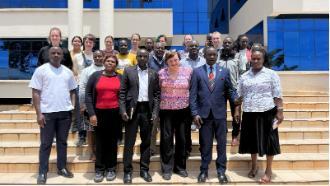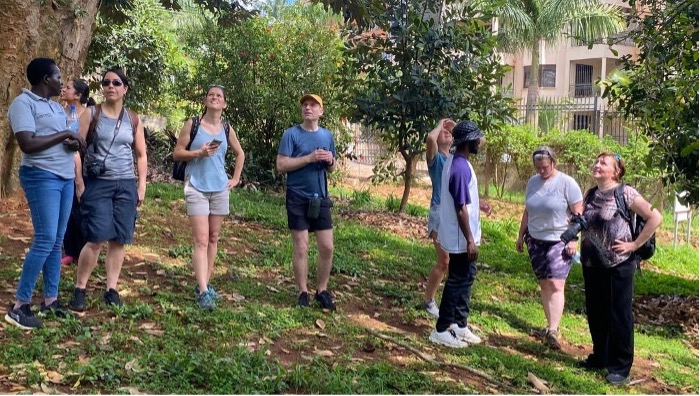UK-Uganda Collaboration Launches Major Study on Crimean-Congo Haemorrhagic Fever Virus
Published: 2 July 2025
Researchers from the MRC-University of Glasgow Centre for Virus Research (CVR) recently travelled to Uganda to launch a new international partnership to study Crimean-Congo haemorrhagic fever virus (CCHFV). The project is part of the USDA/UKRI-funded Ecology and Evolution of Infectious Diseases (EEID) programme.
Researchers from the MRC-University of Glasgow Centre for Virus Research (CVR) recently travelled to Uganda to launch a new international partnership to study Crimean-Congo haemorrhagic fever virus (CCHFV). The project is co-led by Professor Emma Thomson at the CVR, Professor Tess Lambe at the University of Oxford, Professor Anna Jolles at Oregon State University and Dr Stella Atim at Uganda Virus Research Institute, and is part of the USDA/UKRI-funded Ecology and Evolution of Infectious Diseases (EEID) programme.
CCHF is a viral infection causing severe haemorrhagic disease and up to 40% case fatality; spread through tick bites and contact with infected patients or animals. The virus is known from Africa, Europe and Asia so far, being endemic in parts including Uganda. The study will investigate the epidemiology, prevalence and transmission of CCHFV in human, tick and animal populations in Uganda. The scientists will explore cross-reactivity and cross-protection following exposure to CCHFV and other related viruses following natural infection and vaccination. Together these data will develop informative hypothesis on the ecology and inform on management of CCHFV and other related viruses in the region. The launch provided a platform for in-depth discussions, combining scientific, public health, and community perspectives, helping to shape the study’s direction and relevance.
The Glasgow team— Professor Emma Thomson, Dr. Shirin Ashraf, Dr. Leah Owen, and Marina Kugler—joined Ugandan partners Dr. Stella Atim and Dr. Yofesi Nikweri to welcome other EEID study researchers from The International Livestock Research Institute (ILRI Kenya), Pirbright Institute (UK), University of Oxford (UK) and Oregon State University (USA). The event was also attended by stakeholders from UVRI, Makerere University, Ministry of Health (MoH) Uganda, community representatives, and social scientists.
The launch opened with remarks from Professor Moffat Nyirenda (Director, MRC/UVRI & LSHTM Uganda Research Unit), Professor Pontiano Kaleebu (Director, UVRI), and Dr. Charles Olaro (Director of General Health Services, Ministry of Health). Their comments underscored the importance of international collaboration in addressing zoonotic diseases. Presentations followed, highlighting Uganda’s ongoing research into tick-borne diseases, with insights from the Research Center for Ticks and Tick-borne Diseases, Makerere University and the National Livestock Resources Research Institute.
Professor Nyirenda said “emerging viruses, particulaly those that are transmitted from animals represent one of the greatest challenges of our time, not just by posing threats to individual lives but also through their impact on the community and the ecosystem.” Professor Kaleebu added that “the work we are going to do here will make a lot of contribution to understanding viruses and really predict what will happen in the future. I am very happy that we continue to train young scientists and continue to bring more collaborations, both locally and internationally.”
Partners also signed a memorandum of understanding (MoU). A symbolic cake-cutting ceremony, featuring the EEID logo, celebrated the intersection of animal, human, and environmental health.

Stella Atim, co-investigator on the EEID project in Uganda took the stage to introduce the room to the Arboviral Infection Study, a long-standing partnership between CVR and UVRI to investigate zoonotic and arboviral infections in Uganda including viral haemorrhagic fevers, of which CCHFV is an important pathogen.
Conversation then moved on to the EEID study, introduced by Professor Anna Jolles from USA. She stressed on how there is a strong link between the field data and computational modelling and how these two provide the perfect synergy to inform on the overall ecology and epidemiology of a disease. Contributions from ILRI, Pirbright, and Oxford addressed key aspects of the project, such as animal surveillance, vaccination challenges, and serological studies.
Professor Emma Thomson said “CCHFV is likely to be a vastly underestimated cause of illness in Uganda and the East African region. It is also an increasing concern in Europe. In collaboration with our partners from the MRC/UVRI & LSHTM Uganda Research Unit, we aim to understand why the virus is more common in some parts of Uganda and not in others. We also aim to understand more about how immune responses to CCHFV and related viruses may protect people against future infection”.
The meeting concluded with a panel chaired by social scientist Mr. Vincent Basajja and study coordinator Yofesi Nikweri, where community and MoH representatives shared their perspectives and expectations with the study team. During this session, the importance of community engagement early in the study, and appropriate feedback was highlighted. Mr. Basajja ended with the very relevant statement of ‘Nothing for us without us’. Closing remarks were delivered by Professor Maxwell Onapa from the Ministry of Agriculture, Animal Industry and Fisheries (MAAIF), highlighting the importance of locally driven research.
The team also did a day visit to one of the study sites; Kalangala, an island south of Entebbe and met the District health officials as well as a civil administrator for the region. Stella Atim represented the team and gave them feedback from the recruitment drive at the site. The officials were interested and optimistic about regional development in the light of the study.


Overall, the event set the stage for a collaborative and impactful research programme, with a strong emphasis on fair partnerships, local context, and community engagement. The study will not only investigate disease dynamics but also integrate environmental, social, and policy dimensions to strengthen preparedness for future public health threats.
During their stay, the Glasgow team also took time to explore the rich biodiversity of Uganda with a guided visit to the Entebbe Botanical Gardens.

Many thanks to UVRI and the organising team for a successful and inspiring launch. More updates on the study’s progress will follow.
First published: 2 July 2025
<< News
Uganda Virus Reseach Institute - Dr Stella Atim, Prof Moffat Nyirenda, Prof Pontiano Kaleebu
University of Glasgow School of Biodiversity, One Health & Veterinary Medicine - Prof Roman Beik
University of Oxford - Oxford Vaccine Group - Prof Teresa Lamb
Oregon State University - Jolles Lab
Oregon State University - Brianna Beechler
Pirbright Institute - Applied Epidemiology - Dr Georgia Limon-Vega

